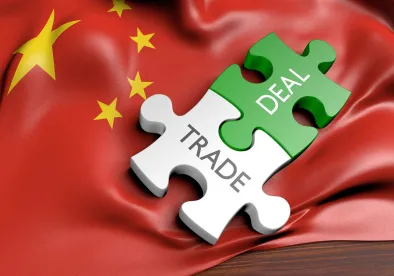Late yesterday, April 3, the U.S. Trade Representative (USTR) released the proposed list of products from China that could be subject to a 25 percent tariff pursuant to the section 301 investigation. This action is in retaliation for China’s allegedly unfair trade practices regarding intellectual property and technology transfer. The notice announcing the tariffs provides companies an opportunity to give comments and attend a hearing in order to possibly have certain products removed from the list of products subject to the 25 percent duties. We note that the deadlines are very tight and that companies attempting to have products removed need to organize quickly, both for comments to USTR and for the USTR public hearing.
I. Background
On March 22, 2018, the White House released a Fact Sheet and the Section 301 Report of the USTR on Chinese unfair trade practices. The Report detailed the USTR’s findings that China had required U.S. companies to transfer their technology to Chinese competitors and otherwise harmed U.S. intellectual property rights holders and U.S. companies seeking to invest in China. Our client alert “White House Releases Section 301 Report and Announces Tariffs and Investment Restrictions on China” details the Report’s findings.
Based on those findings, President Trump ordered the USTR to publish a proposed tariff retaliation list by April 6, 2018 – 15 days from the publication of the Report. The USTR has just released its “Notice of Determination and Request for Public Comment Concerning Proposed Determination of Action Pursuant to Section 301: China’s Acts, Policies, and Practices Related to Technology Transfer, Intellectual Property, and Innovation,” in which it recommends increasing the duty rate that covers more than 1,300 tariff lines to 25 percent. These tariffs are to be imposed on approximately $50 billion worth of Chinese imports. The sectors subject to this retaliation against China include aerospace, information and communication technology, robotics and machinery.
II. Notice and Comment
It is important to note that, pursuant to section 304(b) of the Trade Act, before the duties on the proposed tariff retaliation list can go into effect there is a notice and comment period in which the public and other stakeholders can voice their comments to the USTR. This is an opportunity to present arguments on why products for which duties may be imposed should be removed from the retaliatory list. The USTR will also hold a public hearing regarding a proposed determination on appropriate action in response to China’s acts, policies and practices. The pertinent due dates and public hearing date, as stated in the Notice, are below.
- April 23, 2018: Due date for filing requests to appear and a summary of expected testimony at the public hearing, and for filing pre-hearing submissions.
- May 11, 2018: Due date for submission of written comments.
- May 15, 2018: Public hearing at the U.S. International Trade Commission (500 E Street SW, Washington, D.C., 20436, beginning at 10:00 a.m. ET).
- May 22, 2018: Due date for submission of post-hearing rebuttal comments.
The USTR invites written comments on various aspects of the proposed action, including specific products targeted, the level of increased duty, and the appropriate aggregate level of trade to be covered by additional duties. Further, the USTR asks that commenters specifically address “whether imposing increased duties on a particular product would be practicable or effective to obtain the elimination of China’s acts, policies, and practices, and whether maintaining or imposing additional duties on a particular product would cause disproportionate economic harm to U.S. interests, including small- or medium-size businesses and consumers.”
In order to appear at the May 15, 2018, Section 301 Committee public hearing, a party must submit requests to appear at the hearing by April 23, 2018. Such a request must include a summary of the testimony to be given, and remarks at the hearing may be no longer than five minutes.
Companies with products that are identified in the Notice, as well as those companies and investors that have interests in China, or may be contemplating potential tie-ups or investments with Chinese companies, should consider commenting on these proposals. As the dates detailed above are fast approaching, it is very important that companies organize quickly to submit comments and to prepare for the USTR hearing.
III. China’s Response
China has swiftly announced its own retaliation by threating to impose a 25 percent tariff on exports such as soybeans, airplanes and automobiles – matching the $50 billion worth of goods the U.S. targeted with its tariffs.





 />i
/>i

